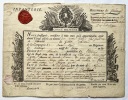- Home page
- Search by criteria
- author : regiment de saintonge infanterie gillot jean antoine beaumont commandant du regiment comte de lambertye lieutenant pour le roi
1 books for « regiment de saintonge ... »Edit
-
Topics
Gillot (1)
Infantry (1)
Regiment (1)
Saintonge (1)
-
Syndicate
ILAB (1)
SLAM (1)
RÉGIMENT DE SAINTONGE INFANTERIE. GILLOT ( Jean Antoine), BEAUMONT (Commandant du régiment), Comte de LAMBERTYE (Lieutenant pour le Roi.
Reference : 5638
(1784)
Congé militaire du nommé Jean Antoine GILLOT, Chasseur au Régiment de SAINTONGE pour un natif de SORCEY en la Province de Lorraine, juridiction de Commercy.
Sarlouis, le 18 mars 1784. 1784 1 feuillet in-folio oblong ( 212 x 286 mm) imprimé à l'encre noire et completé à la main à l'encre brune, cachet de cire rouge du régiment et cachet humide rouge estompé; et au dos est rédigé et signé par l'intendant du régiment, le détail reçu par ce soldat. (salissures, traces de plis, défauts d'usage.)
Congé militaire de Jean Antoine GILLOT, Chasseur au Régiment de Saintonge. Cette unité dinfanterie française créé en 1684 fait partie des forces terrestres impliquées dans la guerre dindépendance Américaine qui comprenaient 5 000 hommes au total, appartenant aux régiments de Bourbonnais, Soissonnais, Saintonge, Royal-Deux-Ponts, deux bataillons d'artillerie de Gribeauval, un bataillon du génie et du matériel de siège. Embarqué à Brest en 1780 les hommes du régiment de Saintonge débarquent avec le corps expéditionnaire à Philadelphie et ils participent aux opérations de Rhode Island. Ces hommes sont impliqués dans toutes les grandes batailles du conflit, notamment en 1781 au siège de Yorktown, victoire décisive de la guerre d'Amérique. Lhistoire na retenu que les noms des officiers qui sy sont illustrés : pendant le conflit, le régiment est commandé à partir 8 mars 1780 par Adam Philippe Blackarth, vicomte de Custines, puis à partir du 11 novembre 1782, par Donatien Marie Joseph de Vimeur, vicomte de Rochambeau. Démobilisé un an après la proclamation de la paix (3 novembre 1783), il est très probable que le chasseur Jean-Antoine Gillot fasse partie des troupes de retour dAmérique. A ce jour les historiens ont surtout recherché les noms des Français morts aux États-Unis de 1777 à 1783. En 1936 est publié une liste des combattants morts en Amérique par Warrington Dawson. Cette liste est le fruit de longues et minutieuses recherches, tant en France quen Amérique. La même année, une plaque commémorative est inaugurée par lambassadeur des Etats-Unis à Versailles. Celle-ci compte 2112. Elle est établie daprès des documents authentiques déposés aux archives nationales et aux archives du ministère de la guerre, publiées par les soins du ministère des affaires étrangères. Beau document, contemporain de la fin du conflit. 1 oblong folio (212 x 286 mm) printed with black ink and completed by hand with brown ink, red wax seal of the regiment and faded red wet seal; and on the back is written and signed by the quartermaster of the regiment, the detail received by this soldier. (soiling, traces of folds, defects of use.) Military leave of Jean Antoine GILLOT, Chasseur in the Regiment of Saintonge. This French infantry unit, created in 1684, was part of the land forces involved in the American War of Independence, which included 5,000 men in total, belonging to the Bourbonnais, Soissonnais, Saintonge, Royal-Deux-Ponts regiments, two Gribeauval artillery battalions, an engineer battalion and siege equipment. Embarked in Brest in 1780, the men of the Saintonge regiment disembarked with the expeditionary force in Philadelphia and took part in the Rhode Island operations. These men were involved in all the great battles of the conflict, notably in 1781 at the siege of Yorktown, a decisive victory of the American war. History has retained only the names of the officers who distinguished themselves in the regiment: during the conflict, the regiment was commanded from March 8, 1780 by Adam Philippe Blackarth, viscount of Custines, then from November 11, 1782, by Donatien Marie Joseph de Vimeur, viscount of Rochambeau. Demobilized one year after the proclamation of peace (November 3, 1783), it is very likely that the hunter Jean-Antoine Gillot was part of the troops returning from America. To this day, historians have mostly researched the names of Frenchmen who died in the United States from 1777 to 1783. In 1936, a list of combatants who died in America was published by Warrington Dawson. This list is the result of long and meticulous research, both in France and in America. The same year, a commemorative plaque was inaugurated by the American ambassador in Versailles. This one counts 2112. It is established according to authentic documents deposited in the national archives and in the archives of the ministry of the war, published by the care of the ministry of foreign affairs. Beautiful document, contemporary of the end of the conflict.
 Write to the booksellers
Write to the booksellers




